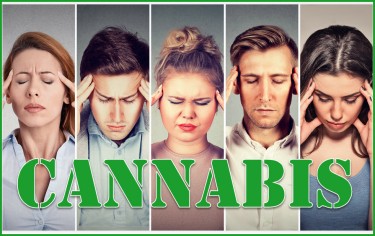
Cannabis for cluster headaches? – New medical studies show why marijuana can help!
Cluster headaches are an excruciating type of headache that usually only affects one side of the head. It is often felt around the eyes and occurs in clusters or cyclical patterns. Migraine headaches tend to appear between the temples and are more common.
Because of the severity of cluster headaches, they are among the most extreme types of pain. Individuals who suffer from cluster periods, which are bouts of frequent headache attacks, can suffer for a prolonged period that can range from weeks to months. The headaches sometimes stop for months during remission.
Cluster headaches aren’t life-threatening, but because they’re so excruciating, it can be difficult to do anything when an attack occurs. Aside from headaches around or behind the eye, the pain can also radiate to other parts of the head, neck, and face; other symptoms may include swelling around the affected eye, facial sweating, stuffy or runny nose, restlessness and tearing.
The exact cause of cluster headaches is still unknown, although doctors do know that there are some irregularities in the hypothalamus that can trigger them. Unfortunately, cluster treatments cannot be cured, although treatment is often aimed at controlling the severity, frequency, and duration of attacks. In order for patients to recover quickly and go about their day without pain, fast-acting pain relievers are necessary.
How Marijuana Can Help
There are a few studies covering the use of cannabis to treat cluster headaches versus other types of headaches, but the data we have is promising. Finally, the hypothalamus, the part of the brain associated with cluster headaches, plays an important role in regulating several processes in the body. Research has also found that cannabinoid and endogenous cannabinoid receptors have been discovered in the hypothalamus.
We also know that when there is a deficiency or malfunction in the endocannabinoid system, headaches can be a symptom. Cluster and migraine headaches are just some of the manifestations. Researchers also believe that the trigeminal vascular system, which is part of the brain, plays a crucial role in cluster and migraine headaches. Endocannabinoids are believed to help regulate this part of the brain, as evidenced by a 2004 study that showed anandamide, an endocannabinoid, was effective at reducing activity in trigeminal vascular neurons.
In addition, serotonin dysfunction in the brain has also been linked to cluster and migraine headaches. Research shows that disorders of serotonin production and the endocannabinoid system are linked.
In 2009, neurologists from New York’s Albert Einstein College of Medicine found that a 19-year-old patient suffering from cluster headache had good results when treated with smoked cannabis. The patient found no relief from conventional treatments such as sumatriptan, prednisone and oxycodone. “However, use of marijuana at the onset of his headache produced complete relief for each attack within five minutes of inhalation,” they wrote in the report.
“Dronabinol was substituted for marijuana for the acute treatment of his cluster headaches; Dronabinol consistently provided dramatic relief within five to 10 minutes of ingestion,” they added.
“We present a cluster headache patient who was unresponsive to multiple acute and prophylactic medications but successfully aborted his attacks with recreational marijuana use…a locus of dysfunction in neuroimaging studies of cluster headache patients,” the authors concluded .
Then, in 2014, a study analyzed 18 patients with chronic cluster headaches. They attempted to treat themselves with cannabis as standard pharmaceutical treatments were of no benefit to them. On average, they smoked about a gram of cannabis. Researchers followed participants from 2 months to 3 years after treatment with marijuana.
Researchers found that 83% of participants reported a 50% or more reduction in headaches, while 61% reported an astounding 90-100% reduction in headaches. Meanwhile, 50% of participants said they noticed a decrease in headache frequency. Additionally, 61% said they were very satisfied with their use of cannabis, as it helped reduce the need for prescription medication while improving quality of life and sleeping habits.
Another study, the results of which were presented at a 2017 neurology conference in Europe, found that daily administration of THC and CBD reduced the frequency of cluster headaches by up to 40%. The results were actually comparable to those of amitriptyline, an antidepressant sometimes used to treat cluster headaches. However, the researchers noted that the results were only favorable if the patient also had migraines.
In addition, they found that the THC-CBD combination reduced migraine severity by 43.5% and cluster headaches by 55%. “We were able to show that cannabinoids are an alternative to established treatments in migraine prevention,” explains Maria Nicolodi, lead researcher of the study, during the 3rd Congress of the European Academy of Neurology in Amsterdam.
When it came to effective dosage, they found that 200mg was ideal; If the participant consumed half of it, there were no reported benefits.
Conclusion
With studies showing marijuana’s painkilling properties, there’s good reason to believe that treatment with THC and CBD is effective in treating and managing cluster headaches. If you suffer from cluster headaches but aren’t finding relief with traditional medications, talk to your doctor about experimenting with medical marijuana today.
CANNABIS FOR HEADACHES, READ MORE…

CANNABIS FOR MIGRANIAS – A DEEP LOOK AT THE EARLY RESULTS!

Post a comment: